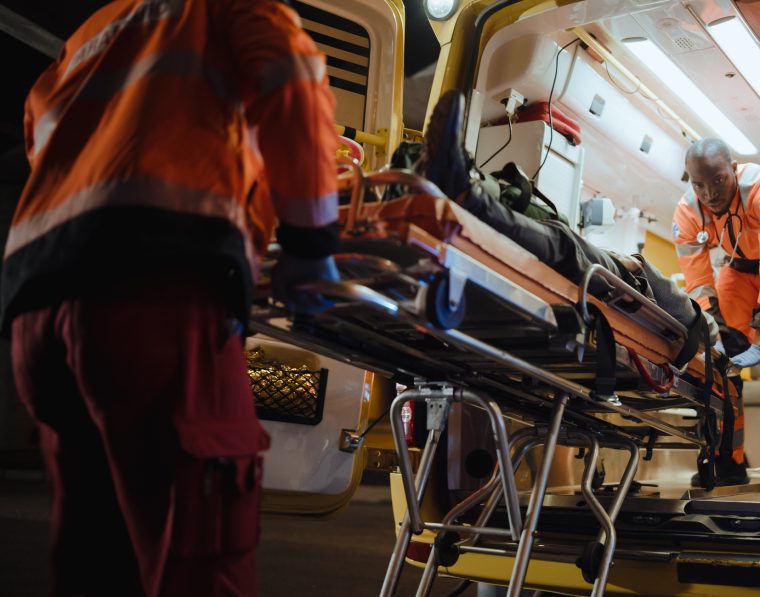The impact of the Regional Whole Blood Program across Virginia’s Shenandoah Valley

The Regional Whole Blood program provides blood to critical emergency patients while being transported via ambulance.
In an emergency, every second counts. This is especially true in the sprawling rural stretches of Virginia’s Shenandoah Valley.
“We’re often racing against time,” says Taylor Mathis, a seasoned paramedic supervisor with over a decade of experience. “When you add distance and bad weather, the clock moves even faster.”
Mathis serves in Waynesboro, Va., a member of the Central Shenandoah Emergency Medical Services (CSEMS) Council. The Council serves five counties and five municipalities, covering nearly 300,000 residents and responding to over 70,000 calls annually. In rural communities like these, transport times can reach 90 minutes, and access to trauma centers is limited. Road closures, mountainous terrain and weather delays only add to the difficulty.
One tool helping to close that gap is the Regional Whole Blood Program, supported in part with a Sentara Cares grant. The program equips select ambulances with whole blood, enabling EMS providers to initiate transfusions at the scene or during transport, before a patient reaches a hospital.
Why whole blood matters in trauma care
Trauma is the leading cause of death for Americans aged 1 to 46. In severe cases, quick intervention and blood transfusion can make the difference between life and death.
“The median time from injury to death is about two hours,” Mathis says. “Having whole blood onboard buys us precious time.”
EMS teams often rely on saline to restore blood volume. “Saline helps replace volume, but it doesn’t carry oxygen,” explains James Larrick, medication logistics and compliance manager for CSEMS. “Blood is the only true replacement for blood.”
Whole blood does both, giving patients a better chance of survival. EMS teams often see near-immediate improvement in patients who receive it.
“Being able to start treatment in the field gives our patients a stronger chance of survival,” Mathis adds.
One such moment came after a tropical system caused severe weather throughout the region. A man was pinned under a tree and unreachable by helicopter due to poor flying conditions. EMS crews extricated him with a chainsaw and transported him by ambulance, transfusing blood on the way to the hospital.
“Because we had blood onboard, we were able to stabilize him en route,” Mathis says. “The trauma team credited the quick administration of blood in part with saving his life.”
Building the whole blood program
Larrick played a key role in launching the program.
“EMS is designed for fast, high-stakes response, and the Regional Whole Blood Program is central to that mission,” he says.
Since its launch in summer 2024, the program has delivered blood nine times in the field, on track to hit its projected annual usage. But implementation requires more than medical training. Whole blood must be carefully stored and transported using specialized refrigeration units that keep it at a safe, consistent temperature. Maintaining proper storage while being ready to deploy at a moment’s notice is a logistical challenge that CSEMS has worked hard to overcome.
Currently, blood is stored in Staunton and Waynesboro, with plans for expansion to other agencies along the I-81 corridor. The team is also working toward wider regional coordination to make sure blood is positioned where it’s most likely to be needed.
“We’ve structured it so EMS teams can connect with blood-equipped units quickly,” Larrick says. “It’s all about getting this lifesaving resource where it’s needed most.”
The critical role of grant funding
Each use of whole blood in the field costs approximately $1,000, covering the blood itself, storage, equipment and handling. EMS agencies in this region are not all tax-funded and operate on limited reimbursements and external support.
“Without grant support from organizations like Sentara, this program likely wouldn’t exist,” Larrick says.
Recent disruptions in state-level EMS funding only intensified this need.
“The Sentara grant helped stabilize us when other sources fell through,” he adds. “Every grant helps ensure a patient in crisis gets the care they need, when they need it.”
Looking towards the future
CSEMS hopes to expand the program throughout more of its region, ensuring more residents have access to this level of emergency care. For now, they are focused on strategic expansion and improving response logistics.
Blood is one of the few treatments that can definitively save a life before a patient ever reaches a hospital.
“It’s not just helpful – it’s the start of definitive care,” says Larrick.
Thanks to community support, regional partnerships and grant funding, CSEMS is turning that promise into reality – one precious unit at a time.
What to do in the event of significant blood loss
Severe bleeding-also called hemorrhage-can be life-threatening if not addressed quickly. If you witness someone experiencing significant blood loss, act fast and follow these steps until emergency responders arrive:
- Call 911 immediately: Don’t delay-professional help is critical. Be ready to describe the situation, location, and visible injuries.
- Apply direct pressure: Use a clean cloth, gauze, or even clothing to press firmly on the wound. Apply steady, direct pressure to slow or stop the bleeding.
- Use a tourniquet if trained: If the bleeding is from an arm or leg and you have proper training, apply a tourniquet above the wound. Note the time it was applied and inform EMS.
- Keep the person calm and still: Help them lie down and elevate their legs if possible. This can slow shock and help maintain blood flow to vital organs.
- Don’t remove objects stuck in the wound: If something is embedded, do not take it out-it may be preventing further blood loss. Apply pressure around it.
- Monitor for signs of shock: Pale skin, rapid breathing, confusion, or cold limbs may signal shock. Keep the person warm and wait for emergency medical services (EMS).
Know this: You don’t need to be a medical professional to save a life. Quick action, calm thinking, and pressure on the wound can keep someone alive until EMS arrives.
Tip: Consider taking a Stop the Bleed™ course or First Aid/CPR training. You never know when you might need to use it.


